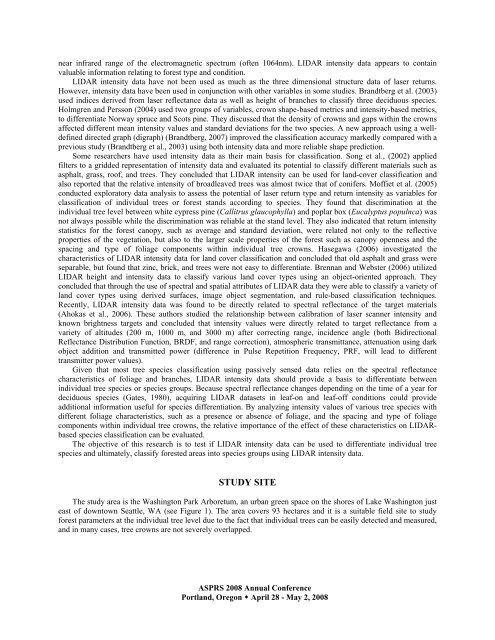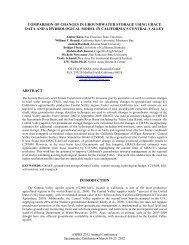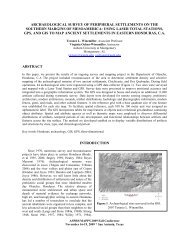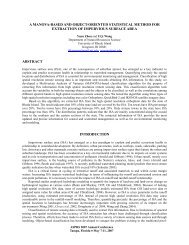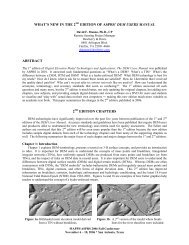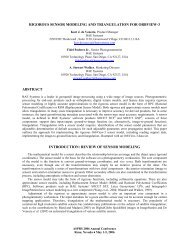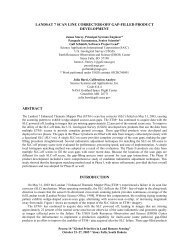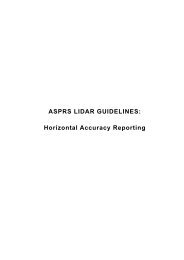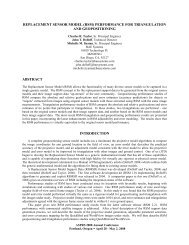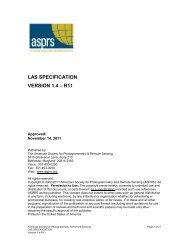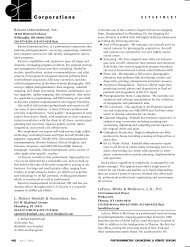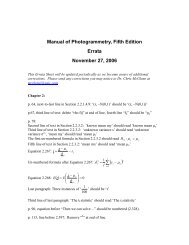Individual Tree Species Identification Using Lidar Intensity Data - asprs
Individual Tree Species Identification Using Lidar Intensity Data - asprs
Individual Tree Species Identification Using Lidar Intensity Data - asprs
Create successful ePaper yourself
Turn your PDF publications into a flip-book with our unique Google optimized e-Paper software.
near infrared range of the electromagnetic spectrum (often 1064nm). LIDAR intensity data appears to contain<br />
valuable information relating to forest type and condition.<br />
LIDAR intensity data have not been used as much as the three dimensional structure data of laser returns.<br />
However, intensity data have been used in conjunction with other variables in some studies. Brandtberg et al. (2003)<br />
used indices derived from laser reflectance data as well as height of branches to classify three deciduous species.<br />
Holmgren and Persson (2004) used two groups of variables, crown shape-based metrics and intensity-based metrics,<br />
to differentiate Norway spruce and Scots pine. They discussed that the density of crowns and gaps within the crowns<br />
affected different mean intensity values and standard deviations for the two species. A new approach using a welldefined<br />
directed graph (digraph) (Brandtberg, 2007) improved the classification accuracy markedly compared with a<br />
previous study (Brandtberg et al., 2003) using both intensity data and more reliable shape prediction.<br />
Some researchers have used intensity data as their main basis for classification. Song et al., (2002) applied<br />
filters to a gridded representation of intensity data and evaluated its potential to classify different materials such as<br />
asphalt, grass, roof, and trees. They concluded that LIDAR intensity can be used for land-cover classification and<br />
also reported that the relative intensity of broadleaved trees was almost twice that of conifers. Moffiet et al. (2005)<br />
conducted exploratory data analysis to assess the potential of laser return type and return intensity as variables for<br />
classification of individual trees or forest stands according to species. They found that discrimination at the<br />
individual tree level between white cypress pine (Callitrus glaucophylla) and poplar box (Eucalyptus populnca) was<br />
not always possible while the discrimination was reliable at the stand level. They also indicated that return intensity<br />
statistics for the forest canopy, such as average and standard deviation, were related not only to the reflective<br />
properties of the vegetation, but also to the larger scale properties of the forest such as canopy openness and the<br />
spacing and type of foliage components within individual tree crowns. Hasegawa (2006) investigated the<br />
characteristics of LIDAR intensity data for land cover classification and concluded that old asphalt and grass were<br />
separable, but found that zinc, brick, and trees were not easy to differentiate. Brennan and Webster (2006) utilized<br />
LIDAR height and intensity data to classify various land cover types using an object-oriented approach. They<br />
concluded that through the use of spectral and spatial attributes of LIDAR data they were able to classify a variety of<br />
land cover types using derived surfaces, image object segmentation, and rule-based classification techniques.<br />
Recently, LIDAR intensity data was found to be directly related to spectral reflectance of the target materials<br />
(Ahokas et al., 2006). These authors studied the relationship between calibration of laser scanner intensity and<br />
known brightness targets and concluded that intensity values were directly related to target reflectance from a<br />
variety of altitudes (200 m, 1000 m, and 3000 m) after correcting range, incidence angle (both Bidirectional<br />
Reflectance Distribution Function, BRDF, and range correction), atmospheric transmittance, attenuation using dark<br />
object addition and transmitted power (difference in Pulse Repetition Frequency, PRF, will lead to different<br />
transmitter power values).<br />
Given that most tree species classification using passively sensed data relies on the spectral reflectance<br />
characteristics of foliage and branches, LIDAR intensity data should provide a basis to differentiate between<br />
individual tree species or species groups. Because spectral reflectance changes depending on the time of a year for<br />
deciduous species (Gates, 1980), acquiring LIDAR datasets in leaf-on and leaf-off conditions could provide<br />
additional information useful for species differentiation. By analyzing intensity values of various tree species with<br />
different foliage characteristics, such as a presence or absence of foliage, and the spacing and type of foliage<br />
components within individual tree crowns, the relative importance of the effect of these characteristics on LIDARbased<br />
species classification can be evaluated.<br />
The objective of this research is to test if LIDAR intensity data can be used to differentiate individual tree<br />
species and ultimately, classify forested areas into species groups using LIDAR intensity data.<br />
STUDY SITE<br />
The study area is the Washington Park Arboretum, an urban green space on the shores of Lake Washington just<br />
east of downtown Seattle, WA (see Figure 1). The area covers 93 hectares and it is a suitable field site to study<br />
forest parameters at the individual tree level due to the fact that individual trees can be easily detected and measured,<br />
and in many cases, tree crowns are not severely overlapped.<br />
ASPRS 2008 Annual Conference<br />
Portland, Oregon April 28 - May 2, 2008


